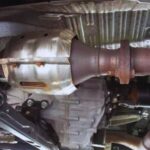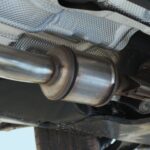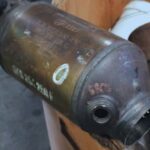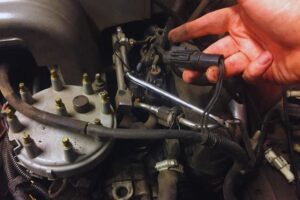As long as the catalytic converter is well maintained, it can last for ten or more years. But if not, they can become clogged, overheated, or prone to damage, which will result in slow engine output. What causes a catalytic converter to go bad?
A catalytic converter goes bad due to:
- Poor Engine Maintenance
- Unburned Fuel in the Exhaust System
- Coolant Leaks
- Bad Spark Plugs
- Short Trips
- Malfunctioning Oxygen Sensor
Read on to learn more about what causes a catalytic converter to go bad, its symptoms, and how a catalytic converter works.
What Causes a Catalytic Converter to Go Bad?
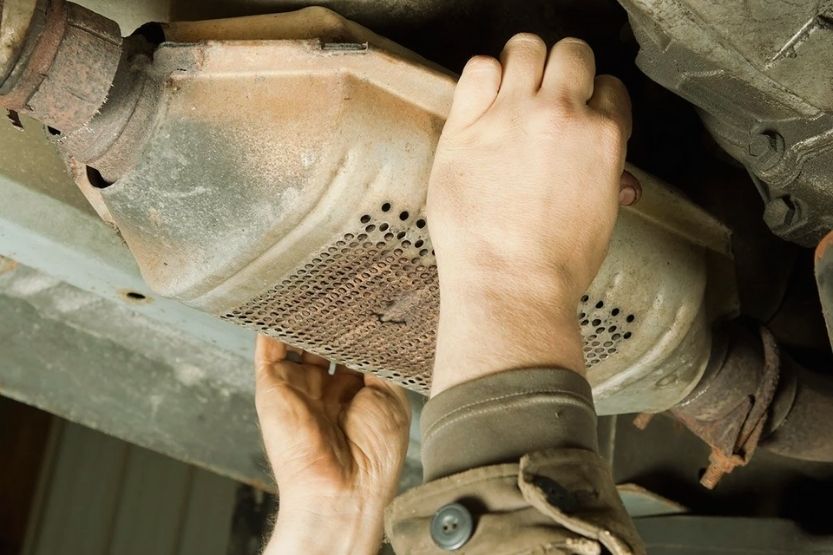
The exhaust systems of all modern vehicles are equipped with a catalytic converter. Its primary function is to convert toxic emissions produced by a car into less harmful gases. If the catalytic converter is not well maintained, it becomes prone to damage, overheated, or clogged.
A catalytic converter can overheat due to excessive amounts of unburned gas, which may be caused by a leaky exhaust valve or a misfiring spark plug. Other causes include:
- A malfunctioning oxygen sensor,
- Unburned fuel, or
- Poor maintenance.
Symptoms associated with a bad converter include:
- Engine misfires,
- Smell of rotten eggs,
- Rattling noises, and
- Black smoke from the exhaust.
A catalytic converter goes bad due to:
- Poor Engine Maintenance
- Unburned Fuel in the Exhaust System
- Coolant Leaks
- Bad Spark Plugs
- Short Trips
- Malfunctioning Oxygen Sensor
Let’s discuss each of these points:
1. Poor Engine Maintenance
Most problems with a catalytic converter result from a damaged car engine. An engine requires to be serviced every so often.
An old, poorly maintained engine will burn oil due to stuck rings, worn-out valve guides, and worn cylinder walls. These occurrences, unfortunately, produce by-products that are harmful to the converter.
Misfiring spark plugs, incorrect timing, and an incorrect air/fuel mixture can also contribute to the failure of the converter and other parts of the engine.
2. Unburned Fuel in the Exhaust System
Usually, fuel is burned up in the combustion chamber to power the car. Any unburned fuel which gets through the chamber enters the exhaust system. This could ignite once it has reached the catalytic converter.
Unfortunately, this will cause the converter to overheat farther from its normal operating limit, resulting in a meltdown.
This could be caused by the following:
- Incorrect timing,
- Improper fuel mixture,
- A defective fuel injector,
- A faulty check valve,
- Sticking float,
- Bad spark plugs, or
- A malfunctioning oxygen sensor.
3. Coolant Leaks
Antifreeze or coolant leaking into the combustion chamber is mainly caused by a blown gasket. When the leak reaches the exhaust system, it will clog the catalytic converter. This will prevent it from working properly.
The leaking coolant produces thick carbon and soot, which block the air passages in the catalytic converter’s ceramic honeycomb structure. This will prevent the converter from removing the exhaust flow’s harmful emissions.
It will also clog the pores of the honeycomb catalyst, limiting the exhaust flow and increasing backpressure. This will then cause heat and exhaust to back up, resulting in internal engine damage.
4. Bad Spark Plugs
A spark plug that misfires or doesn’t fire forces unburned fuel to enter the exhaust system. The unburned fuel would then ignite inside the hot catalytic converter. This will cause the ceramic catalyst to either partially or completely melt down.
5. Short Trips
If you usually drive your car only on short trips and rarely long distances, the catalytic converter may not get hot enough to burn hydrocarbons completely.
This can cause it to clog after some time. To prevent this, an occasional long-distance drive for at least 15 minutes would allow the exhaust to heat up sufficiently to burn off the buildup of deposits in the converter completely.
6. Malfunctioning Oxygen Sensor
An oxygen sensor that isn’t properly working may send inaccurate exhaust gas readings to your car’s computer. This can cause an improper fuel mixture condition.
If the mixture is too rich, the catalyst could meltdown from the burning fuel in the converter. The converter will not convert hydrocarbons into safe elements if it is too lean.
How Much Platinum, Rhodium, and Palladium Is in a Catalytic Converter?
What Are the Symptoms of a Bad Catalytic Converter?

The symptoms of a bad catalytic converter include the following:
- Engine Misfire
- Sulfur/Rotten Egg Smell from the Exhaust
- Check Engine Light Turns On
- Startup Problems
- Reduced Fuel Efficiency
- Poor Acceleration
- Reduced Engine Performance
- Increased Emissions
- Rattling Noises
- Black Exhaust Smoke
Let’s briefly discuss each one of them:
1. Engine Misfire
A misfiring engine is one of the first symptoms of a bad catalytic converter. It indicates that the catalytic converter has gotten clogged and is overheating. Because of this, the combustion process in the cylinder is incomplete and will lead to other damages if left unattended.
Once you notice your engine misfiring, take it as a sign to call a mechanic to check your converter before the catalytic components start to melt. Don’t let the problem worsen and spread to the other parts of your car, or it will cost you dearly in additional repairs.
2. Sulfur/Rotten Egg Smell from the Exhaust
The smell of sulfur or rotten eggs coming out of the exhaust is a significant symptom of a faulty catalytic converter. The sulfuric smell comes from the sulfate in the fuel, which the converter transforms into odorless gases.
If your vehicle smells of rotten eggs, it could mean that there is a problem with the converter’s internal components. Have your converter repaired or replaced, if necessary, as soon as you smell this strange odor.
3. Check Engine Light Turns On
Whenever there is an issue with your car’s engine, an internal computer will activate the check engine light to tell you to check your engine. It will light up any engine problems, including a bad catalytic converter.
Whatever the issue is, it is best to heed the warning light and have your car checked by a mechanic.
4. Startup Problems
If you’re having problems starting your car, it could mean the catalytic converter is clogged. It most likely fails to convert toxic gases into less toxic ones.
This will cause the converter to keep the gases in the engine. It will increase exhaust pressure, causing the engine to sputter or stall and making it hard to start your car.
5. Reduced Fuel Efficiency
When a catalytic converter clogs, it reduces airflow, resulting in the engine burning up more fuel.
Acceleration is weak, and exhaust flow is insufficient, forcing you to step on the gas pedal more. This will make the engine pump more fuel into the cylinders, resulting in a richer fuel mixture than needed.
A faulty converter also keeps the engine from getting its required oxygen. It then makes it work harder and consumes more fuel.
This means your car will go for fewer miles on a gallon of fuel than normal. Suffice to say that an inexplicable decrease in gas mileage is indicative of an issue with the catalytic converter.
6. Poor Acceleration
A clogged catalytic converter can also cause an engine to lose efficiency. It reduces the flow of exhaust, likewise reducing engine power during acceleration.
A blockage may result from a buildup of carbon in the honeycomb structure. Also, it may result from the melting of internal parts due to excess heat from unburned fuel.
You can check if the decrease in power acceleration results from a clogged converter. Just get someone to hold the car at 1800 to 2000 rpm.
Then, place your hand behind the tailpipe. If you feel the exhaust’s heat, it is indeed caused by a clogged converter.
7. Reduced Engine Performance
A bad catalytic converter may create major backpressure, which reduces the performance of your car’s engine. This would cause your car to shake often. Also, your engine will often stall on the road due to a sudden outburst of pressure.
8. Increased Emissions
The catalytic converter won’t minimize the number of gaseous emissions inside the malfunctioning exhaust system. If you experience a higher carbon emission level from your car, it is a sign of a clogged converter. Don’t leave it unattended to prevent further damage to the entire exhaust system.
9. Rattling Noises
While driving or idling, a faulty catalytic converter will produce a rattling sound under your car. This rattling will usually get louder when you’re starting the car.
Excessive heat or damage in the catalytic converter causes the honeycomb materials to break, which results in rattling sounds. If you hear any unusual noises in your car, take it to a mechanic for inspection. If the problem does lie with the converter, replace it immediately to prevent further damage.
10. Black Exhaust Smoke
When a catalytic converter gets clogged, the trapped gases build up in the exhaust. They then get thicker and darker, exiting the tailpipe as ominous black smoke.
Again, what causes a catalytic converter to go bad? The possible causes of a bad catalytic converter include an unsuitable fuel mixture, malfunctioning oxygen sensor, faulty fuel injector, sticking float, or a damaged check valve.
How Long Can You Drive With A Bad Catalytic Converter?
What Is a Catalytic Converter?

Metal Chest Attached to the Underside of a Car
A catalytic converter is a metal chest attached to the underside of a car. It has two pipes protruding from it.
Responsible for Bringing in Polluted Fumes From the Engine’s Cylinders
One of these pipes, the input, connects to the engine. It is responsible for bringing in hot, polluted fumes from the engine’s cylinders, wherein the fuel is burned to generate power. The second pipe is the output connected to the exhaust or tailpipe.
Has an Internal Ceramic Structure
The catalytic converter has an internal ceramic structure coated with a catalyst. The catalyst speeds up a chemical reaction. In this case, it is the removal of pollution without changing itself.
Chemical Reactions Occur on Its Surface
As toxic gases produced by the engine pass through the catalytic converter, chemical reactions occur on its surface. The pollutant gases break apart and convert into safer gases which will harmlessly blow out into the air.
We all should remember that catalytic converters require the use of unleaded fuel. This is because the lead present in regular fuel prevents the catalyst from taking the pollutants from the exhaust gases.
How Does a Catalytic Converter Work?
Gas Passes Through a Dense Catalyst-coated Ceramic Structure
The gases pass through the dense catalyst-coated ceramic structure within the catalytic converter. It is in a honeycomb pattern so that the gases will immediately touch a larger catalyst area. This allows them to convert more efficiently.
Two Different Catalysts
Usually, a catalytic converter has two different catalysts. The first takes care of oxide pollution through a chemical process known as reduction. This focuses on the removal of oxygen. Through this process, nitrogen oxides break up into harmless nitrogen and oxygen gases.
The other catalyst makes use of an opposite chemical process known as oxidation. Oxidation is the process wherein oxygen converts carbon monoxide into carbon dioxide. A second oxidation reaction changes the unburned hydrocarbons in the exhaust into water and carbon dioxide.
Chemical Reactions Carried Out By Catalytic Converters
Essentially, three different chemical reactions are taking place simultaneously. Most catalytic converters are usually referred to as three-way catalytic converters. This is because they carry out all three reactions.
Those few less-effective ones that only do the two oxidation reactions are called two-way catalytic converters. Once the catalyst has performed its function, the following will come out of the exhaust:
- Oxygen,
- Nitrogen,
- Carbon dioxide, and
- Water in the form of steam.
Why Are Thieves Targeting Catalytic Converters?
What Happens When a Catalytic Converter Goes Bad?
Catalytic converters are built to last for a car’s lifetime, an average of 10 years or more. But they may still wear out if they are not appropriately maintained. Also, they can break down if they become affected by unattended damage from other parts of the car.
When a catalytic converter goes bad, it fails to detoxify the exhaust gases. This causes it to produce air pollution. Also, it can affect vehicle mileage and damage the other components of the exhaust system.
If you notice that your catalytic converter has a problem, you must immediately bring your car to a mechanic.
Conclusion – What Causes a Catalytic Converter to Go Bad?
So, to reiterate, a catalytic converter goes bad due to:
- Poor Engine Maintenance
- Unburned Fuel in the Exhaust System
- Coolant Leaks
- Bad Spark Plugs
- Short Trips
- Malfunctioning Oxygen Sensor
A bad catalytic converter’s symptoms include the following:
- Engine Misfire
- Sulfur/Rotten Egg Smell from the Exhaust
- Check Engine Light Turns On
- Startup Problems
- Reduced Fuel Efficiency
- Poor Acceleration
- Reduced Engine Performance
- Increased Emissions
- Rattling Noises
- Black Exhaust Smoke
When a catalytic converter malfunctions, it becomes a hazard to your car and the environment. Now that you know what causes a catalytic converter to go bad, you should identify the symptoms as they occur.
Allow a professional mechanic to check your converter at the first sign of trouble before the issue worsens.
Read next:


